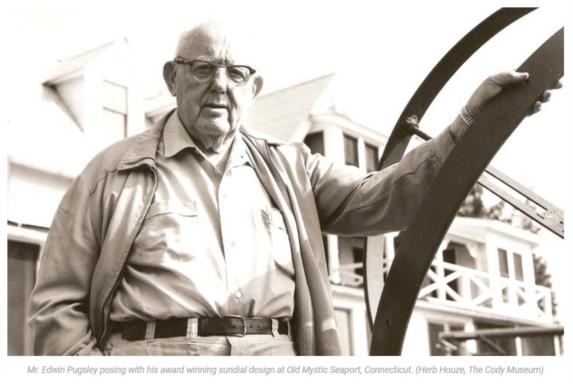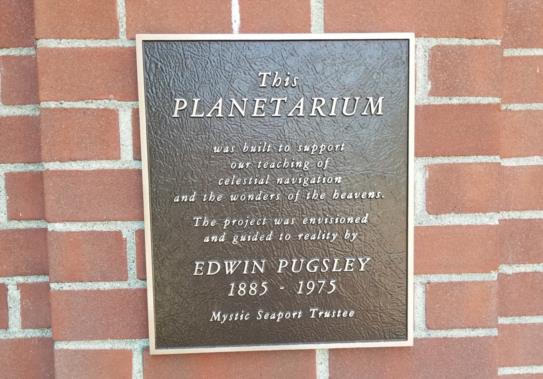
NavList:
A Community Devoted to the Preservation and Practice of Celestial Navigation and Other Methods of Traditional Wayfinding
From: Frank Reed
Date: 2024 Jun 18, 08:13 -0700
Geoff Hitchcox, you wrote:
"So although one could add a "correction graph" to the Sundial (along with the "Equation of Time" table), could not the Sundial be tipped toward the SOUTH, by adding suitable packing under just three legs - so the Gnomon was now at the correct latitude angle? Although this would now make the HORIZON ring tilted by 7.2753 degrees, the Sundial would give the correct solar time."
Yes. In a more likely re-build, the sphere could be sawed away from the base, rotated 7° and then welded back to its base.
SHORT ASIDE: You suggested 7.2753°. I realize that you understand that no one would get anywhere near that latter number, but let's stop for a minute to consider how tiny that is. What I'm suggesting is, just for laughs, let's take all those digits seriously! The last digit here is a ten-thousandth of a degree. How much is that in latitude on the ground? Here it can be useful for standard American units and folks like me who persist in using American units, at least, to remember that a second of arc of latitude is just about 100 feet. Or on the SI side of the table we can also remember that 90° of latitude is 10,000km by the original definition, and therefore 0.900° of latitude is almost exacty 100km (with some variation in latitude due to oblateness of the globe and some smaller variation due to changes in the definitions of units). And if we divide that by 100, it implies that 0.009° is 1km or dividing by 100 again, we find that 0.00009° of latitude is 10m (almost exactly). And finally bumping that up by 11%-ish, we get 0.0001° is 11.11m on the ground. So if my armillary sphere is correct where it stands with a latitude adjustment of 7.2753°, then if I move it north by a mere 11m (or 37 feet), I will have to change the adjustment to 7.2752°. Could I do that... or even get close?? How big is that in the sphere itself? We can do the math by pure proportion. If it's 11m on a sphere (the Earth!) that is somewhat more than 11,000km in diameter, how big is it on a sphere (the sundial itself) that is about one meter in diameter. That scales the Earth down by a factor of 11 million, so the original 11m offset would be also scaled down by a factor of 11 million, leaving a millionth of a meter, also known as one micron --about the size of a bacterium! Ha ha. :)
Back to the idea of re-building... This was considered occasionally, but only for a few minutes before common sense prevailed. The biggest problem is opening that can of worms that says on the label "your sundial is broken". Once bureaucratic heads hear those words, there is a real risk that they will throw out the sundial with the gnomon, recycle the metal, and call it mission accomplished. The next concern is aesthetic. Making this change would leave the sphere with a tilted horizon circle and a tilted prime vertical circle, too. There's no way to remove them or adjust them separately. The result of a simple "tilting" by 7° would be unattractive. In addition, there's a sort of sailing-ship "wind vane" on top that would have to be moved. In short, the project quickly transitions from a minor re-build to a complete re-construction. And who wants that?
What do visitors get from the armillary sphere sundial? I have occasionally observed visitors looking at and discussing the sundial over the course of many decades. Only a tiny handful understand what it is. Seeking the shadow of the gnomon is too difficult with all those other bars and arcs, despite their attraction. Some visitors even look for the shadow on cloudy days or at times of day when the sundial is clearly covered by the shade of nearby trees (which were much smaller, of course, in the early 1960s when the sundial was first placed there). In recent years, I have encountered people talking about the "occult magic" of the armillary sphere as regularly as they talk about the science of it. They're not interested in it as a sundial. The other sundials around the planetarium building get radically less attention, mostly because of placement, but also, I think, because they seem less mysterious to casual visitors. If it looks like a sundial, well then --obviously-- it's a sundial, and we don't need those, right?
So who broke it? Was it Waugh or Pugsley? As I understand it, they were both involved in the design and creation of the three sundials around the Treworgy Planetarium, and they both knew enough to get it right. They were both passionate about sundials. The catch is that most projects like this involve a few other artisans, and there's room to lay the blame on some, now nameless, third party! And there's another catch: this armillary sphere is probably not the original. I remember hearing a story about some earlier version that was not sufficiently "weather worthy" (see the image below). The other sundials around the planetarium building both received upgrades over the decades. The sundial high on the wall on the south side of the building was converted from a simple "stick" gnomon to a clever anchor some time in the 1970s (you could see that in the pictures I posted a couple of weeks ago). The east-facing mural sundial was repainted with new sundial mottoes more than once, and at some point, one of the hour lines was mislabeled. If the original armillary sphere was replaced with a near facsimile in the 1960s, which, I think, is possible, then that's probably when the co-latitude versus latitude error occurred. Although an industrious researcher could probably spend some days digging around in the museum archives to investigate this possibility, I am not that "industrious researcher"! It's a minor thing, after all.
By the way, don't put much stock in sundial histories online. There are a few websites with seemingly specific historical accounts of the creation and construction of sundials. These are anecdotal histories, re-telling "stories" and personal memories about sundials. They're valuable up to a point, but very little of their information is "sourced". Sometimes we can spot hints of trouble. For example, regarding the sundials at "Mystic Seaport Museum", we can find multiple sources that refer to the sundials at "Old Mystic Seaport", as if that was the name of the place. But it was never called that. It's another example of the unfortunate failure to secure a trademark-able name that has be-deviled poor "old" Mystic Seaport or Mystic Seaport Museum since it was first created. You'll notice that the caption of the photo of Edwin Puglsey, below, mentions "Old Mystic Seaport, Connecticut". It was never that!
Edwin Pugsley was in interesting character. He surely would have been a NavLister, but he was born in the wrong century and retired by about 1950. Pugsley was relatively wealthy from his years at Winchester Arms (see PS), and he was one of the first generation of the museum's trustees at a time when the trustees could throw money at projects to get them done. He deserves the "local credit" for the construction of the Treworgy Planetarium. He was an avid collector of navigation instruments and had significant expertise in celestial navigation. But he couldn't launch a project as large as a planetarium on his own without unanimous support from the museum's other trustees and financial backers, and the impetus for that support came from the man who deserves the secondary "international credit" for this planetarium and many others, namely Sergei Korolev. He was the "rocket scientist" behind the massive R-7 rocket in the USSR (and its impractical nuclear missile version), and of course he designed and launched Sputnik in 1957. After that, the money rolled in, and Pugsley's dream of a planetarium at Mystic Seaport Museum was easily turned into reality.
Frank Reed
PS: Connecticut has a big history in guns. In fact, Winchester Repeating Arms, where Pugsley was a major figure for some decades, had a huge factory located about a mile from the main campus of Yale University in New Haven, Connecticut. Guns were a big deal in the creation of wealth in Connecticut back then. If you do an internet search on "Pugsley" and "Winchester" you'll find all sorts of stories. There's an especially funny tale from a speech he made in 1955 (he was 70 by then) talking about growing up in Florida and wanting a "Colt 45 pistol" when he was eight or ten years old. He notes that "everybody carried a gun down there just as soon as they could waddle". Florida in 1895 was as much "Wild West" in 1895 as the West was.








